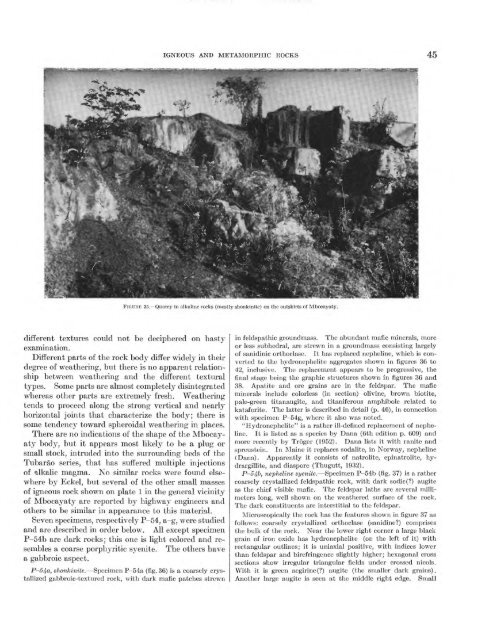Geology and Mineral Resources of Paraguay A Reconnaissance
Geology and Mineral Resources of Paraguay A Reconnaissance
Geology and Mineral Resources of Paraguay A Reconnaissance
- No tags were found...
You also want an ePaper? Increase the reach of your titles
YUMPU automatically turns print PDFs into web optimized ePapers that Google loves.
IGNEOUS AND METAMORPHIC ROCKS 45FIGURE 35. Quarry in alkaline rocks (mostly shonkinite) on the outskirts <strong>of</strong> Mbocayaty.different textures could not be deciphered on hastyexamination.Different parts <strong>of</strong> the rock body differ widely in theirdegree <strong>of</strong> weathering, but there is no apparent relationshipbetween weathering <strong>and</strong> the different texturaltypes. Some parts are almost completely disintegratedwhereas other parts are extremely fresh. Weatheringtends to proceed along the strong vertical <strong>and</strong> nearlyhorizontal joints that characterize the body; there issome tendency toward spheroidal weathering in places.There are no indications <strong>of</strong> the shape <strong>of</strong> the Mbocayatybody, but it appears most likely to be a plug orsmall stock, intruded into the surrounding beds <strong>of</strong> theTubarao series, that has suffered multiple injections<strong>of</strong> alkalic magma. No similar rocks were found elsewhereby Eckel, but several <strong>of</strong> the other small masses<strong>of</strong> igneous rock shown on plate 1 in the general vicinity<strong>of</strong> Mbocayaty are reported by highway engineers <strong>and</strong>others to be similar in appearance to this material.Seven specimens, respectively P-54, a-g, were studied<strong>and</strong> are described in order below. All except specimenP-54b are dark rocks; this one is light colored <strong>and</strong> resemblesa coarse porphyritic syenite. The others havea gabbroic aspect.P-54a, shonkinite. Specimen P-54a (fig. 36) is a coarsely crystallizedgabbroic-textured rock, with dark mafic patches strewnin feldspathic groundmass. The abundant mafic minerals, moreor less subhedral, are strewn in a groundmass consisting largely<strong>of</strong> sanidinic orthoclase. It has replaced nepheline, which is convertedto the hydronephelite aggregates shown in figures 36 to42, inclusive. The replacement appears to be progressive, thefinal stage being the graphic structures shown in figures 36 <strong>and</strong>38. Apatite <strong>and</strong> ore grains are in the feldspar. The maficminerals include colorless (in section) olivine, brown biotite,pale-green titanaugite, <strong>and</strong> titaniferous amphibole related tokataforite. The latter is described in detail (p. 46), in connectionwith specimen P 54g, where it also was noted."Hydronephelite" is a rather ill-defined replacement <strong>of</strong> nepheline. It is listed as a species by Dana (6th edition p. 609) <strong>and</strong>more recently by Troger (1952). Dana lists it with ranite <strong>and</strong>spreusteiri. In Maine it replaces sodalite, in Norway, nepheline(Dana). Apparently it consists <strong>of</strong> natrolite, epiriatrolite, hydrargillite,<strong>and</strong> diaspore (Thugutt, 1932).P-54b, nepheline syenite. Specimen P-54b (fig. 37) is a rathercoarsely crystallized feldspathic rock, with dark sodic(?) augiteas the chief visible mafic. The feldspar laths are several millimeterslong, well shown on the weathered surface <strong>of</strong> the rock.The dark constituents are interstitial to the feldspar.Microscopically the rock has the features shown in figure 37 asfollows: coarsely crystallized orthoclase (sanidine?) comprisesthe bulk <strong>of</strong> the rock. Near the lower right corner a large blackgrain <strong>of</strong> iron oxide has hydronephelite (on the left <strong>of</strong> it) withrectangular outlines; it is uniaxial positive, with indices lowerthan feldspar <strong>and</strong> birefringence slightly higher; hexagonal crosssections show irregular triangular fields under crossed nicols.With it is green aegirine(?) augite (the smaller dark grains).Another large augite is seen at the middle right edge. Small
















